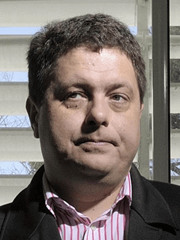Speakers
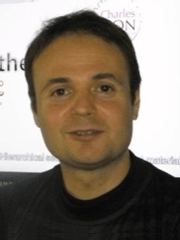
Nicolas GIUSEPPONE
Institut Charles Sadron, CNRS and University of Strasbourg, France
Dynamic Supramolecular Polymers as Functional Materials
Abstract: The confluence of conformational and constitutional features related to supramolecular polymers and self-assemblies has recently opened a series of very intriguing possibilities in chemical science. For instance, within this framework, emerging lines of investigations have been directed towards the development of dynamic materials and devices.[1] They can be defined as multi-component chemical systems which, thanks to the reversibility of their interconnections within networks of competing reactions, and to their sensitivity to environmental parameters, aim at performing modular functional tasks by responding to external stimuli. The behavior of such dynamic materials is by essence more complex than the one produced by their static or single-component counterparts and as such, they hold higher potentialities in terms of information processing and functionality tuning. We will discuss some of our works concerning such responsive systems along these lines and, more particularly, we will focus on electroactive supramolecular polymers[2] and on equilibrium and non-equilibrium polymer-motor conjugates.[3]
Selected references:
- (a) Busseron, E., Ruff, Y., Moulin, E., Giuseppone, N., Nanoscale 2013, 5, 7098; (a) Moulin, E., Cormos, G., Giuseppone, N., Chem. Soc. Rev. 2012, 41, 1031; (b) Giuseppone, N., Acc. Chem. Res. 2012, 45, 2178.
- (a) Moulin, E., Niess, F., Maaloum, M., Buhler, E., Nyrkova, I., Giuseppone, N., Angew. Chem. Int. Ed. 2010, 49, 6974; (b) Faramarzi, V., Niess, F., Moulin, E., Maaloum, M., Dayen, J.-F., Beaufrand, J.-B., Zanettini, S., Doudin, B., Giuseppone, N., Nature Chem. 2012, 4, 485; (c) Moulin, E., Cid-Martin, J., Giuseppone N., Adv. Mat. 2013, 25, 477; (d) Armao, J. J., Maaloum, M., Ellis, T., Fuks, G., Rawiso, M., Moulin, E., Giuseppone, N. J. Am. Chem. Soc. 2014, 136, 11382; (e) Nyrkova, I., Moulin, E., Armao, J. J., Maaloum, M., Heinrich, B., Rawiso, M., Niess, F., Cid J.-J., Jouault, N., Buhler, E., Semenov, A., Giuseppone N., ACS Nano 2014, 8, 10111; (f) Busseron, E., Cid, J.-J., Wolf, A., Du, G., Moulin, E., Fuks, G., Maaloum, M., Polavarapu, P., Ruff, A., Saur, A.-K., Ludwigs, S., Giuseppone, N., ACS Nano 2015, 9, 2760; (g) J. J. Armao, Y. Domoto, T. Umehara, M. Maaloum, C. Contal, G. Fuks, E. Moulin, G. Decher, N. Javahiraly and N. Giuseppone, ACS Nano 2016, 10, 2082-2090; (h) J. J. Armao, P. Rabu, E. Moulin and N. Giuseppone, Nano Lett. 2016, 16, 2800-2805.
- (a) Du, G., Moulin, E., Jouault, N., Buhler, E., Giuseppone, N. Angew. Chem. Int. Ed. 2012, 51, 12504; (b) Goujon, A., Du, G., Moulin, E., Fuks, G., Maaloum, M., Buhler, E., Giuseppone, N. Angew. Chem. Int. Ed. 2016, 55, 703; (c) Li, Q., Fuks, G., Moulin, E., Maaloum, M., Kulic, I., Foy, J. T., Giuseppone, N., Nature Nanotech. 2015, 10, 161.
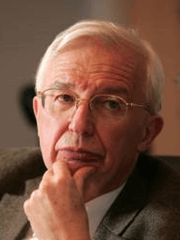
Jean-Marie LEHN
ISIS - University of Strasbourg, France
Institute for Advanced Study, City University of Hong Kong, Hong Kong
Perspectives in Chemistry:
From Supramolecular Chemistry towards Adaptive Chemistry
Abstract: Supramolecular chemistry is actively exploring systems undergoing self-organization, i.e. systems capable of spontaneously generating well-defined functional supramolecular architectures by self-assembly from their components, on the basis of the molecular information stored in the covalent framework of the components and read out at the supramolecular level through specific non-covalent interactional algorithms, thus behaving as programmed chemical systems.
Supramolecular chemistry is intrinsically a dynamic chemistry in view of the lability of the interactions connecting the molecular components of a supramolecular entity and the resulting ability of supramolecular species to exchange their components. The same holds for molecular chemistry when the molecular entity contains covalent bonds that may form and break reversibility, so as to allow a continuous change in constitution by reorganization and exchange of building blocks. These features define a Constitutional Dynamic Chemistry (CDC) covering both the molecular and supramolecular levels.
CDC introduces a paradigm shift with respect to constitutionally static chemistry. It takes advantage of dynamic diversity to allow variation and selection and operates on dynamic constitutional diversity in response to either internal or external factors to achieve adaptation.
CDC generates networks of dynamically interconverting constituents, constitutional dynamic networks, presenting agonistic and antagonistic relationships between their constituents, that may respond to perturbations by physical stimuli or to chemical effectors.
The implementation of these concepts points to the emergence of adaptive and evolutive chemistry, towards a chemistry of complex matter.
References:
- Lehn, J.-M., Supramolecular Chemistry: Concepts and Perspectives, VCH Weinheim, 1995.
- Lehn, J.-M., Dynamic combinatorial chemistry and virtual combinatorial libraries, Chem. Eur. J., 1999, 5, 2455.
- Lehn, J.-M., Toward complex matter: Supramolecular chemistry and self-organization, Proc. Natl. Acad. Sci. USA, 2002, 99, 4763.
- Lehn, J.-M., From supramolecular chemistry towards constitutional dynamic chemistry and adaptive chemistry, Chem. Soc. Rev., 2007, 36, 151.
- Lehn, J.-M., Chapter 1, in Constitutional Dynamic Chemistry, ed. M. Barboiu, Topics Curr. Chem, 2012, 322, 1-32.
- Lehn, J.-M., Perspectives in Chemistry - Steps towards Complex Matter, Angew. Chem. Int. Ed., 2013, 52, 2836-2850.
- Lehn, J.-M., Perspectives in Chemistry - Aspects of Adaptive Chemistry and Materials, Angew. Chem. Int. Ed., 2015, 54, 3276-3289.

David PARKER
Department of Chemistry, Durham University, Durham, UK
EuroTracker Dyes and Probes
Abstract: Highly emissive, sensitised lanthanide complexes based on macrocyclic ligands have been used extensively in vitro as analytical probes and in cellulo to study biological function. They are bright, possess long-lived, sharp emission bands and exhibit high photostability, and have been used to assess pH, pM and pX.[1] Such favourable photophysical properties make them promising candidates for other applications, such as security labelling and as anti-counterfeiting tools. The annual cost of counterfeiting to the global economy is estimated to be $1.7 trillion, and in the last 10 years, the Bank of England has withdrawn >5 million counterfeit banknotes from circulation, with a value of nearly £100 million.
Chiral europium complexes, may be resolved by chiral HPLC. Each enantiomer gives rise to mirror-image circularly polarised luminescence (CPL). This fingerprint can be exploited as a security feature for the labelling of authentic items such as banknotes and certificates. Simple methods of detection of the complexes have been developed, using band pass filters attached to a commercially-available DSLR camera or CCD detector. Chiral image contrast has also been explored, selecting the sign of the circularly polarised light, over a given wavelength region.
 Figure 1. Structure of the RRR-Λ-(δδδ) enantiomer and CPL spectra of enantiomeric complexes.
Figure 1. Structure of the RRR-Λ-(δδδ) enantiomer and CPL spectra of enantiomeric complexes.
- S. J. Butler, M. Delbianco, L. Lamarque, B. K. McMahon, E. R. Neil, R. Pal, D. Parker, J. W. Walton and J. M. Zwier, Dalton Trans., 2015, 44, 4791-4803.
- Roles and responsibilities of intermediaries: Fighting counterfeiting and piracy in the supply chain, International Chamber of Commerce, Paris, 2015.
- The Bank of England, www.bankofengland.co.uk/banknotes/Pages/about/counterfeits.aspx, (accessed Nov 2015).
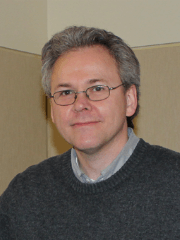
Olof RAMSTRÖM
Department of Chemistry
KTH - Royal Institute of Technology, Stockholm, Sweden
Dynamic Systems for Reaction Networks, Synthesis and Catalysis
Abstract: Dynamic systems based on reversible reactions can generate reaction networks for applications in selective synthesis and catalysis processes. These complex systems can undergo self-sorting, or be resolved, to provide optimal constituents in response to external or internal pressures. In this presentation, examples of such self-sorting and resolution processes will be given, with special emphasis on kinetic approaches. Examples include selection and self-sorting of catalyst systems, and systemic resolution using transition-metal- and biocatalysis for different asymmetric transformation processes.
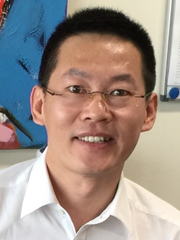
Jiaobing WANG
School of Chemistry
Sun Yat-Sen University, Guangzhou, China
Janusarene
Abstract: A series of novel bivalent supramolecular building blocks, janusarene (a two-face aromatic compound), will be presented. The easy-accessible janusarene is highly suitable for various functional 1D assembly. In addition, biocompatible deep-cavity janusarene which enables general nanoscale guest encapsulation in water will also be covered.


